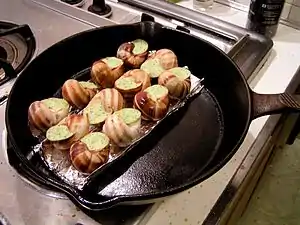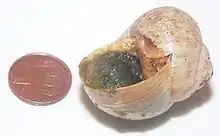Escargot
Escargots, IPA: [ɛs.kaʁ.ɡo], (French for snails) is a dish consisting of cooked edible land snails. They are often served as an hors d'oeuvre and consumed by the French people, as well as people in Germany, Great Britain, Italy, Portugal, Sardinia, and Spain. They are also typical of the cuisines of Cyprus, Crete, and other areas of mainland Greece, as well as of the North African countries Tunisia, Algeria and Morocco. The word escargot is also sometimes applied to living examples of those species which are commonly eaten in this way.[1][2][3]

Etymology
The first recorded use in English of the French word escargot to mean "edible snail" dates from 1892. The French word (1549) derives from escaragol (Provençal) and thence escargol (Old French), and is ultimately – via Vulgar Latin coculium and Classical Latin conchylium – from the Ancient Greek konchylion (κογχύλιον), which meant "edible shellfish, oyster". The Online Etymological Dictionary writes, "The form of the word in Provençal and French seems to have been influenced by words related to scarab."[4][5]
Snail species
Not all species of land snail are edible, and many are too small to make it worthwhile to prepare and cook them. Even among the edible species, the palatability of the flesh varies from species to species.
In France, the species Helix pomatia is most often eaten. The "petit-gris" Cornu aspersa and Helix lucorum are also eaten. Several additional species, such as Elona quimperiana, are popular in Europe; see heliciculture.
Apple snails (Pila polita) are also consumed in Asia and can be found in Asian markets in North America; a nutritional analysis shows them to be a good source of protein.

History
Snail shells have been found in archaeological excavations, indicating snails have been eaten since prehistoric times.[6][7] A number of archaeological sites around the Mediterranean have been excavated yielding physical evidence of culinary use of several species of snails.[8]
The Romans in particular are known to have considered escargot an elite food, as noted in the writings of Pliny. The edible species Otala lactea has been recovered from the Roman-era city Volubilis in present-day Morocco.[9] More recently, African land snails have been known to be edible.[10]
In the late 1980s, escargots represented a $300-million-a-year business in the United States.[11] May 24 has been designated "National Escargot Day" in the United States.[12][13]
Preparation


In French cuisine, the snails are typically purged, killed, removed from their shells, and cooked (usually with garlic butter, chicken stock or wine), and then placed back into the shells with the butter and sauce for serving. Additional ingredients may be added, such as garlic, thyme, parsley and pine nuts. Special tongs for holding the shell and forks for extracting the meat are also normally provided, and they are served on indented metal trays with places for six or 12 snails.
In Cretan cuisine the snails are first boiled in white wine with bay leaves, celery and onion and then coated with flour and fried with rosemary and vinegar.
In Maltese cuisine, snails (Maltese: bebbux) of the petit gris variety are simmered in red wine or ale with mint, basil and marjoram. The snails are cooked, and served in their shells.
In Moroccan cuisine, snails, also called ''Ghlal'', are a very popular street food. They are cooked in a jar filled with hot water, special spices and herbs. After cooking time, Moroccan snails are served in small bowls with their broth and consumed hot. Moroccan snails are mostly enjoyed during winter as they are believed to be beneficial for health, especially when dealing with the common cold or rheumatism.[14]
Nutritional value
Like most molluscs, escargots are naturally high in protein and low in fat content. Escargots are estimated to contain 15% protein, 2.4% fat and about 80% water.[15]
Heliciculture
The snails are first prepared by purging them of the likely undesirable contents of their digestive systems. The process used to accomplish this varies, but generally involves a combination of fasting and purging or simply feeding them on a wholesome replacement. The methods most often used can take several days. Farms producing Cornu aspersum for sale exist in Europe and in the United States. In both regions, escargot are considered a delicacy.[1] Farm-raised snails are typically fed a diet of ground cereals.
References
- Snail Facts and Information. "Snails as Food". Snail-World. Retrieved April 9, 2016.
- The Guardian: food and drink
- UKTV: recipes
- Harper, Douglas (2016). "Escargot". Online Etymological Dictionary. Retrieved April 9, 2016.
- Trésor de la Langue Française informatisé
- Prehistoric edible land snails in the circum-Mediterranean: the archaeological evidence., D. Lubell. In J-J. Brugal & J. Desse (eds.), Petits Animaux et Sociétés Humaines. Du Complément Alimentaire Aux Ressources Utilitaires. XXIVe rencontres internationales d'archéologie et d'histoire d'Antibes, pp. 77-98. Antibes: Éditions APDCA.
- Are land snails a signature for the Mesolithic-Neolithic transition? In, M. Budja (ed.), Neolithic Studies 11. Documenta Praehistorica XXXI: 1-24. D. Lubell.
- A. Eastham, Alastair Small, Michael Ross MadceqrefvrevrecKinnon, Stephen G. Monckton, David S. Reese, Robert J. Buck (2002) The Excavations of San Giovanni Di Ruoti: The Faunal and Plant Remains, University of Toronto Press, 232 pages ISBN 0-8020-4865-X
- Hogan, C. Michael. Volubilis, The Megalithic Portal, ed. Andy Burnham (2007) megalithic.co.uk
- Hard as snails
- Goodyear, Dana (August 15, 2011). "Grub". The New Yorker.
- "National Escargot Day – May 24". National Day Calendar. 2016. Retrieved April 9, 2016.
- Smith, Emily (May 24, 2012). "National Escargot Day". CNN / Eatocracy. Retrieved April 9, 2016.
- "Top 10 Best Moroccan Street Food You Must Try - MoroccanZest". Moroccan Zest. 2018-09-03. Retrieved 2018-09-29.
- Snail (escargot) nutritional value
External links
| Wikimedia Commons has media related to escargot. |
| Wikimedia Commons has media related to Snail-based food. |
| Look up escargot in Wiktionary, the free dictionary. |